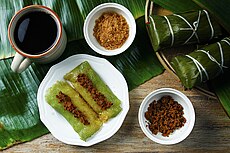


Suman sa lihiya, a variety of suman wrapped in banana leaves.
| |
| Alternative names | Rice cake |
|---|---|
| Place of origin | Philippines |
| Main ingredients | Glutinous rice |
Suman,orbudbud, is an elongated rice cake originating in the Philippines. It is made from glutinous rice cooked in coconut milk, often wrapped in banana leaves, coconut leaves, or buliorburi palm (Corypha) leaves for steaming. It is usually eaten sprinkled with sugar or laden with latik. A widespread variant of suman uses cassava instead of glutinous rice.
There are numerous varieties of suman, with almost every town or locality having its speciality. Some are described below:[1]
Suman wrapping is a unique art in itself, and can be traced to pre-colonial roots which have had contact with Indian traditions. Wrappers utilize a wide variety of indigenous materials such as palm, banana, anahaw and bamboo leaves, coconut shells, and others. Some wrappings are simple folds such as those found in the binuo and the kamoteng kahoy, resulting in rectangular suman. Others are in vertical coils like the inantala, giving it a tubular form. Still others are in pyramid-like shapes, like the balisungsong. Some forms of suman are eaten like ice cream–with cones made from banana leaves, and still others are in very complex geometric patterns like the pusu ("heart"). Some are woven into the shape of a banana blossom (which in the Philippines is referred to as the banana plant's "heart"), or the pinagi (from the word pagi, meaning stingray), a complex octahedral star.[1]
Suman dishes (as well as savory variants like binalot and pastil) are differentiated from pusô (orpatupat), in that the latter use woven palm leaves.[1][6]
|
| |||||||||||
|---|---|---|---|---|---|---|---|---|---|---|---|
| Main dishes |
| ||||||||||
| Noodles and pasta |
| ||||||||||
| Sausages |
| ||||||||||
| Lumpia and turón |
| ||||||||||
| Breads, cakes, and pastries |
| ||||||||||
| Desserts |
| ||||||||||
| Condiments and ingredients |
| ||||||||||
| Beverages |
| ||||||||||
| |||||||||||